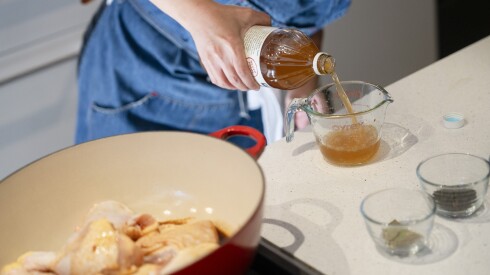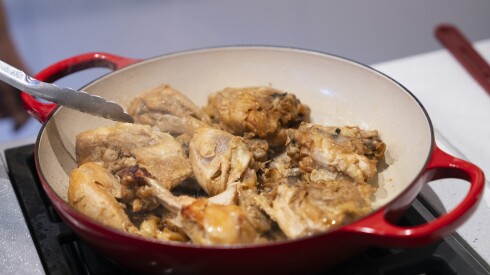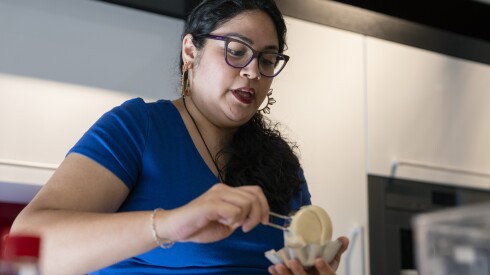You can learn a lot about someone through their adobo.
The way one prepares the unofficial national dish of the Philippines is guided by preference, says Mia P. Manansala, the author of the award-winning “Tita Rosie’s Kitchen Mystery” series, starring Lila Macapagal, the 20-something cafe owner who solves murders in the tiny Illinois town of Shady Palms. This interpretive approach to the recipe means there are countless variations, all subject to debate.
“[Adobo] is one of those things that’s scary to serve to other Filipinos because it’s so ingrained in your head of what your idea of adobo is,” said the 39-year-old Forest Park resident.
Manansala didn’t make the dish herself until she started writing and developing recipes for her first book, “Arsenic and Adobo,” because her father, who passed away in 2018, was the cook of the family. “I missed my father’s cooking and this is a way to connect to him,” she said.
Food is central to Manansala’s cozy mystery series, which comes to an end with the sixth and final book, “Death and Dinuguan” ($19, Berkley), released this week; the “cozy” mystery is a light-hearted subgenre of crime fiction that tones down the sex and violence and usually features an amateur sleuth. The books center on food and family and vividly paint a portrait of Filipino culture. She lovingly pays homage in her books, which all include recipes.
On a recent Wednesday, Manansala walked me through making three dishes — a Filipino chiffon cake, her adobo and an Asian twist on Rice Krispies treats — that figure prominently in her books and draw on her life experiences as the daughter of immigrants growing up in Chicago.
Making mocha mamon
Mamon, individual-sized cloud-like chiffon cakes, are a popular sweet treat during breakfast and merienda, which is a light meal or snack between lunch and dinner. Mamon first appeared in Manansala’s fourth book, “Murder and Mamon,” and she brings it back in the latest with a variation that hearkens back to childhood.
Manansala grew up in Hermosa, a predominantly Hispanic neighborhood on the Northwest Side where there wasn’t a large Filipino community. For birthdays, her family would celebrate with ube sheet cakes. Although the purple yam is ubiquitous on social media these days as a trendy flavor, the bright-purple birthday cakes confused her childhood friends — and Manansala felt self-conscious.
“I’m a child, so I want to fit in,” she said. She told her parents to get “a regular cake” like chocolate.
“My mom’s like, ‘OK, I’ll get something kids would like. Mocha.’”
That experience echoes a scene in “Death and Dinuguan.” Lola Flor, the grandmother of protagonist Lila— the series’ sleuth and, in one case, a prime suspect — is testing a recipe for mocha mamon at the request of a customer who wants something with chocolate.
“Mocha is close enough,” Lola Flor says.
Spoiler alert: There is no chocolate in Manansala’s mocha mamon recipe. After beating together egg yolks, vegetable oil and instant coffee dissolved in hot water, cake flour, baking powder and salt go in. For true mocha flavor, Manansala suggests swapping in cocoa powder for some of the instant coffee.
The key to achieving the signature lightness and airiness of these sponge cakes is folding whipped egg whites into the batter. “I don’t make these that often, because sometimes I don’t have a very gentle hand, and they can be very rubbery if you’re not careful when you’re folding in the meringue,” she said.
Despite not making mamon often, Manansala is an avid home baker. She started baking traditional Filipino baked goods and sweets for her family for fun as she got into her late teens and early 20s. But she left the savory dishes to her dad, “the master.”
Measuring with your heart
Manansala’s dad worked long hours at his job at a printing facility in Morton Grove, so the family rarely ate together during the week. But on the weekends, he would wake up early to shop with Manansala’s grandmother for the feast-like meals he would prepare. The large multigenerational household included Manansala’s parents, the maternal and paternal grandparents, her two brothers and two cousins.
Adobo was often on the table. Manansala explains that there’s a difference between “weekday adobo” and “weekend adobo.” “There’s the cooking you do when you want the dish to be really good, and there’s the everyday cooking,” she said.
“Adobo” is the word for a Filipino cooking technique that entails braising meat, seafood or vegetables in a mixture of vinegar, garlic and soy sauce. (Purists will say seasoning with salt is more authentic to the dish, because it predates Spanish colonization and trade. Soy sauce was an ingredient later introduced by Chinese traders.) Some families add regional flourishes, such as coconut milk and chile peppers; others improvise with personal additions, such as tomatoes.
For weekday chicken adobo, the ingredients — chicken thighs, soy sauce, vinegar, water, bay leaves, black peppercorns and a bulb and a half of garlic — go into a pot at the same time and simmer until the meat is fully cooked.

Vinegar is a key ingredient in adobo, a Filipino cooking technique that entails braising meat, seafood or vegetables in soy sauce (or salt), vinegar, black peppercorns, bay leaves and garlic. The unofficial national dish of the Philippines varies by region to region and even household to household due to how families prefer their adobo.
Pat Nabong/Sun-Times
Weekend adobo calls for marinating the meat overnight in a bag. When Manansala’s dad had more time on the weekends, he would also sear the chicken in a pan to crisp the skin. At the end, he reduced the braising liquid to a thickened sauce.
But the level of browning and the consistency of the sauce is personal preference, says Manansala. “I leave that to the cook,” she said.
Her version goes heavy on the vinegar and adds a touch of sugar (an idea she got from New York Filipino restaurateur Nicole Ponseca, who adds sugar to bistek, a citrus and soy sauce marinated steak dish) for balance — and to appease her husband, who isn’t a fan of vinegar. “I know [sugar is] not traditional, but we’re the ones eating it,” she said.
The recipe calls for 10 cloves, but the amount of garlic is just a guideline. “It’s very much to your preference. And each family is different. Each region is different. You measure garlic with your heart,” she said.

Chicken is seared in a pan, an extra step for elevating “weekday adobo” (when families just want to get dinner on the table quickly) to “weekend adobo” (taking extra steps such as marinating meat overnight, searing and reducing the braising liquid for better presentation and flavor).
Pat Nabong/Sun-Times
Experimenting with flavor
While not Filipino, Lila’s (and Jae’s) Honey Butter Rice Krispies Treats typify Manansala’s approach to baked goods and sweet treats — bold flavors highlighted by the contrast of sweet and salty ingredients.
She developed a taste for honey butter snacks, a sweet and salty flavor combination that is popular in South Korea, while teaching English in the country for three and a half years. Her recipe calls for white miso, which adds another layer of complexity.
Browning the butter and honey together to almost burnt gives the mixture a rich depth of flavor. Rushing the process, Manansala says, won’t result in the nuttiness that complements the sweet marshmallows. “You want it a little bit brown, so you don’t need to keep stirring it. You want to let it sit for a minute,” she said while monitoring the mixture on the stove.
Even though the book series is coming to an end, Manansala is constantly testing recipes and coming up with new ideas, which she shares on Ko-Fi, an online platform for content creators. Recent inventions have included pumpkin pie butter mochi, apple cider salabat (Filipino ginger tea) and buko pandan (a creamy Filipino dessert made with shredded young coconut and pandan-flavored jelly cubes) eggnog.
As Manansala has improved as a baker, her recipe development process has pushed her to experiment with flavors. For a recent housewarming party she added gochujang, the Korean red-chile paste, to her honey butter Rice Krispies treats.
“I’ll give you these flavors you wouldn’t have thought to include in [Rice Krispies treats]. I’ve made ube Oreo. I’ve made buko pandan. I’ll put those things in there so it’s familiar but still different.”
Showing care through food
Manansala says that the character Tita Rosie, who owns the restaurant of the series’ name, is partly inspired by her father. Rosie is not known for public displays of affection, but she will bring food to people going through tough times, such as cooking favorite dishes to console her boyfriend’s family after a brutal assault on a loved one.
Her restaurant, Tita Rosie’s Kitchen, is always open as a place for her niece Lila to talk through her latest case with friends — and the latest tsismis, or gossip — over plates of silog, a breakfast dish of meat, like cured beef or Spam, served with rice and eggs.
“The idea of food as a love language is something that I got from him, the idea of acts of service, of how you show you love,” Manansala said.
But Tita Rosie’s Kitchen is now closed.
“I still love this world, but both me and my publisher were like, it might be time to wrap it up,” said Manansala, who doesn’t want the series to turn formulaic, a cozy mystery type of “Mad Libs.”
“I also want to write other things,” she says.
Manansala is working on a new project, slated for release in 2027, which she says she can’t discuss just yet. She also released a new young adult novel this year, “Death in the Cards,” about a high school tarot reader who investigates the disappearance of her latest client; its sequel, “Murder Under the Full Moon,” will come out in 2027.
And naturally, Manansala said, “There’s still food in it because I’m still Filipino.”



